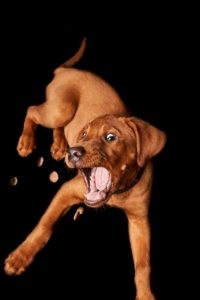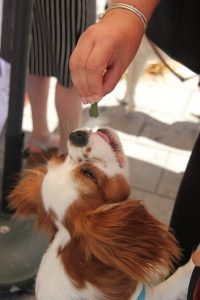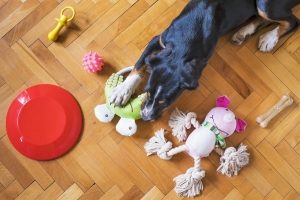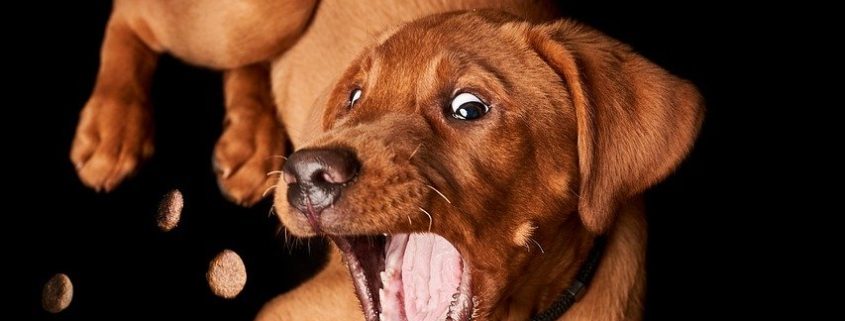Ask Crystal: Turning Crazy for Treats into Productive Training

Dear Crystal,
My pup is very food motivated. As soon as we start training, she gets so excited for treats that she randomly starts performing commands that I didn’t ask for (sits, lays down, runs to her bed and waits, lays in her crate). She only follows about half the commands I give because she’s so focused on the treats in my pocket. I tend to ignore any trick she offers that I did not ask for. I’ve tried to randomly reward throughout the day with hidden treats and give life rewards and ask her to say please. She does pretty well with this. I guess I’m wondering if I should just stay away from “training sessions”? Any tips on how to have short training sessions where she’s not too obsessed with the reward to perform the command? Sometimes I think she ignores me because she knows I don’t have a treat. Apparently, I’ve made some mistakes and I’m hoping to fix them! Also, she’s not excited enough for a toy to work for it. Looking forward to any tips on training sessions/treats/weaning treats…THANK YOU!!
Sincerely,
Crazy for Treats
Dear Crazy,
First, let me say, Bravo for teaching your pup all those amazing cues! I love, love a dog that loves to train. What a wonderful problem to have. I can almost see the joy on your dog’s face in anticipation of training. Side note: research has shown that the anticipation is more reinforcing than the actual treat. Kind of like the anticipation of a vacation can be better than the actual vacation.
The behavior you describe where the dog starts throwing behaviors at you, is pretty common. It tends to be really common in the early stages of training. The dog may not understand the cue signals completely. They just know you like it when they do this or how about this? It sounds like you understand not to reinforce a behavior you did not ask for. The reason is as you likely know, that the dog will not learn to distinguish the correct hand or verbal signals if they frequently get rewarded for guessing.
One thing to be sure of is that you are not asking for the same behaviors in the same order every time. An example would be, every time you practice your positions you say to your dog, “sit, down, stand”, in that order. What tends to happen if you use the same order is the dog just chains the behaviors together and doesn’t necessarily know what you are asking for. It’s one of the reasons why we teach 3 positions of sit, stand, down so that you can mix up the positions more. If you only teach two positions of sit and down, then the dog has a 50% chance of being rewarded for guessing.
Some trainers suggest starting to ask the dog for multiple behaviors for one treat rather than a one cue to treat ratio. An example might be shake, spin, down and then treat. You can also work towards a variable reinforcement schedule by not always reinforcing with a treat following a cue. This is after the dog has some saliency with the behavior.
We should also be sure to vary the type of treats we are using for different behaviors. Use lower value treats like kibble, biscuits for well-known cues, in familiar locations. Some dogs just seem to lose their mind for higher value treats. These dogs will usually work for kibble. Use the lowest value treat that you can get away with using. I like using the dog’s food ration for training. I usually work on things that require a lot of repetition since it allows a lot of practice for a lower number of calories.
A lot of dogs focus too much on the area where the treat is located. When possible, try to have treats in jars located all over the house. That way you can ask her to do something and then easily walk over to the treat to reinforce. You can also take the treats that would have been in your pocket and set them up out of reach somewhere.
 The other mistake I see people make a lot is not fading the lure quickly enough. When using a lure to train, there are a couple of tips that will make it so that the dog does not need to see a treat in your hand before performing the cue. First, you want to be sure to lure with one hand and feed with the other. That way the dog gets used to the food coming from the other hand. Do not feed the dog the lure! Next, once the dog is performing the behavior with the lure, take the lure out of your hand and hold your hand as if there were food in it. The next step is to start holding your hand more in a position which looks like the hand signal. You slowly work on that until the hand looks like the final hand signal.
The other mistake I see people make a lot is not fading the lure quickly enough. When using a lure to train, there are a couple of tips that will make it so that the dog does not need to see a treat in your hand before performing the cue. First, you want to be sure to lure with one hand and feed with the other. That way the dog gets used to the food coming from the other hand. Do not feed the dog the lure! Next, once the dog is performing the behavior with the lure, take the lure out of your hand and hold your hand as if there were food in it. The next step is to start holding your hand more in a position which looks like the hand signal. You slowly work on that until the hand looks like the final hand signal.
You may also teach your dog a target cue which is used to have the dog move as they follow the hand. That way you could do some lure training without having food in your hand.
In regards to staying away from “training sessions”, the way I train every day is more like what you are probably doing. I try to find ways to incorporate a little training here and there into everyday life. Train while you walk, while you play, while you make dinner, etc. It’s also important that we are training in a variety of locations so that our dogs can begin to generalize the behavior into a variety of situations and locations.
You don’t mention is you use a marker word or a clicker. A mark word is a word that marks the correct behavior and means a reinforcement is coming. It helps dogs isolate the behavior that earned the reinforcement. There is a great idea from trainer Kikopup on Youtube.com on training a calm mark word. We should always be aware of the effect that our movements have on dogs. Fast movements can cause a dog to become aroused. Moving away can cause a dog to move. The idea here is to move your hand very slowly towards the dog and deliver the treat very slowly and calmly.
Kikopup also has a training method to help with her excitement around food. Start by wearing a treat bag around the house with low value food in it for at least five days. Kibble might be a good treat to start with. Anytime you see your dog behaving calmly and not interested in trying to get the food, very calmly walk over a place a treat between his paws. We absolutely can and should reinforce calm behavior. As she gets better and better at this, we can up the value of the treat to make it more difficult.
SMART X50 is a training method by trainer Kathy Sdao that I have been recommending for everyone as a really easy way to incorporate training into daily life and capture behaviors. It stands for “See Mark And Reward Training 50 times a day.” You start each day with 50 treats and look for behaviors that you like from your dog like laying down calmly, sitting or looking at something and not barking. You mark and reward the behavior as you see it. This can help train you to start noticing the good things your dog is doing and reinforcing them.
It is important that you are trying to address this now because we don’t want him to always get overly excited when you ask him to do behaviors. That type of excitement can stay with the dog for his life. We want to build in training that reinforces calmness and is incorporated throughout the dog’s life.
Life Rewards and Say Please help to introduce nonfood reinforcers which are very valuable and necessary in a dog’s training. By teaching them that there are a variety of reinforcers that come at many different times and they are not always food, we can help wean off so many treats. What I have seen is that my dogs are much more willing to do what I ask them to because they make not see the reinforcer but they know I am good for it. In fact, I think for a lot of dogs, life rewards can be more valuable than food. How about getting to chase a squirrel as your reward or getting to go play with a dog friend? You incorporate training in that way and it is much more salient to the dog in those situations.
 You can condition toys to be more reinforcing than they currently are. If you pair the toy with food enough times, the conditioning with apply to the toy alone eventually. It would look something like, present a treat, then tug. Repeat many times, like thousands and you have yourself classical conditioning. The same thing can happen with praise. Many people feed the dog a treat and say, “Good Dog”. If you do that enough times, the dog gets the same feeling from the “Good Dog” as they do with the food.
You can condition toys to be more reinforcing than they currently are. If you pair the toy with food enough times, the conditioning with apply to the toy alone eventually. It would look something like, present a treat, then tug. Repeat many times, like thousands and you have yourself classical conditioning. The same thing can happen with praise. Many people feed the dog a treat and say, “Good Dog”. If you do that enough times, the dog gets the same feeling from the “Good Dog” as they do with the food.
Keep up the good work and with some small tweaks you should be able to train her with a little less excitement. Good luck and happy training!
Until next time,
Crystal
Submit your own pet behavior question for Crystal here:







